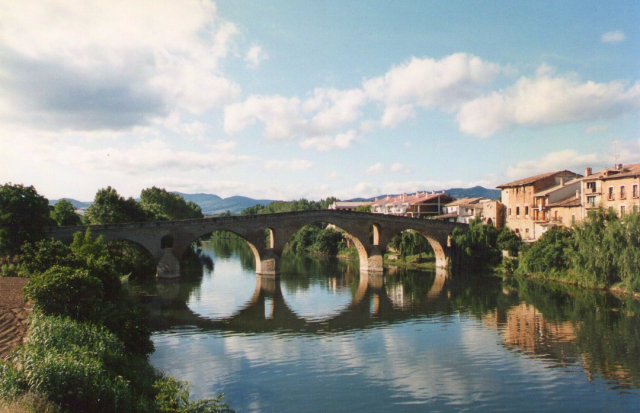Do you know the legend of the txori de Puente la Reina?
The miracle of this town in Navarra continues to captivate its inhabitants and pilgrims
Puente de la Reina is a town in Navarra whose most famous attribute is, of course, the bridge. In this town, the two variants of the French Way cross: the one that comes from Roncesvalles and the one that comes from Somport. The stage that leads here is marked by the Alto del Perdón, but the town where the day ends should not go unnoticed.
The txori and the Virgin
The inhabitants of Puente de la Reina collect a legend that has the bridge itself as its protagonist, or more specifically, the carving of the virgin that was in its central tower. Transit over the Pilgrims' Bridge had been uninterrupted since its construction in the 11th century, and in 1824 it continued to be so. Therefore, the presence of a txori (a little bird, in Basque) soon caught the attention of many, who passed each spring day next to the image of the Virgen del Puy.
The most intriguing thing about the matter is not that the txori passed by, but that he took pains to clean the dust and cobwebs from the carving with his wings. He even dipped his beak in the Arga River to wash the Virgin's face. Of course, the event was soon described as a miracle.
Every spring the txori (although it had to be more than one, due to the years that passed) visited Puente de la Reina to take care of the Virgin, and the town celebrated it. It became an event accompanied by religious celebrations and the festivities of the inhabitants. All the commotion that was formed did not matter to the bird, which despite the expectation it caused was oblivious to it, concentrated on its work.
During the First Carlist War
Ten years after the first appearance of the txori, the Royal Army formed a detachment in Puente de la Reina to avoid possible attacks by the Carlist army. The people sympathized with the Carlists, something that did not please the government troops. Furthermore, his arrival coincided with the return of the txori, so the atmosphere in the town was one of pure concern. The Count of Vía Manuel, who led the detachment, disdained this tradition and fired his cannons next to the bridge. This action caused public disturbances throughout the town.
Two weeks later, the Carlists defeated the Royal Army and the Count of Vía Manuel was captured and later shot in August 1834. This news was interpreted in Puente de la Reina as divine punishment for having despised the txori, and his miraculous nature grew even more.
The end of the miracle
The bird continued with its work caring for the Virgin, they are documented between 1840 and 1843. That was the last year in which the txori was able to perform its miracle, since the liberal government ordered the demolition of the bridge tower that housed the carving of the Virgin. Although the image is preserved in the altarpiece of the parish church of San Pedro, the txori did not appear again.
Despite the fact that the miracle of the txori ended almost two centuries ago, its legend lives on among the people of Puente de la Reina. From there it continues to spread thanks to the pilgrims who cross the famous Pilgrims' Bridge.
Routes
Blog
 ¿Vas a hacer el camino de Santiago? Cuida tus pies antes y después
¿Vas a hacer el camino de Santiago? Cuida tus pies antes y después
 5 razones por las que contratar un seguro de viajes
5 razones por las que contratar un seguro de viajes
 Formas de hacer un logotipo
Formas de hacer un logotipo
 La importancia del registro de llamadas durante tu viaje por el Camino de Santiago
La importancia del registro de llamadas durante tu viaje por el Camino de Santiago
Information
Points of interest
Cities & Towns | Hostels | Lodgings | Restaurants | Saddlery | Doctors | Points of interest | Bikes workshop
Contact us | Privacy policy | Cookies policy | | Terms of use | Authorship | Web Map | Consentimiento
© Copyright LA VOZ DE GALICIA S.A. Polígono de Sabón, Arteixo, A CORUÑA (ESPAÑA) Inscrita en el Registro Mercantil de A Coruña en el Tomo 2438 del Archivo, Sección General, a los folios 91 y siguientes, hoja C-2141. CIF: A-15000649
